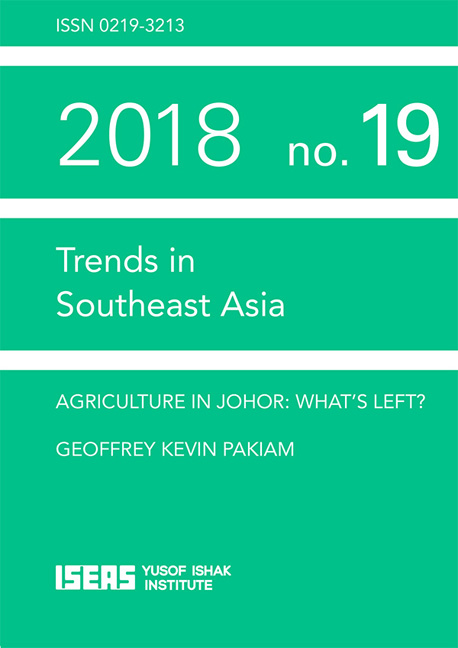Agriculture in Johor: What's Left?
Published online by Cambridge University Press: 25 August 2018
Summary
INTRODUCTION
For those living in Singapore or Peninsular Malaysia, accustomed to having fresh chicken eggs every other morning, chances are that your breakfast comes from one of 17 million broody hens raised in the Malaysian state of Johor. If this comes as a surprise, you are probably not alone. Most recent commentaries concerning Johor's economic growth give the impression that agriculture is now a historical relic. The Iskandar Malaysia development project — accompanied by glittery real estate, oil and gas refining, complex manufacturing, mass tourism, and sophisticated healthcare offerings — now hogs the limelight. Indeed, even for field-leading scholarship on greater Malaysia's economic development, agriculture has been conspicuous by its relative absence, sidelined by an overwhelming focus on manufacturing and services.
This essay represents an initial attempt to redress this imbalance. I ask two basic questions: what is left of agriculture in Johor? And why? My argument is similarly direct: although agriculture's share of Malaysian gross domestic product (GDP) and employment has fallen significantly, much remains, particularly in Johor. Amidst rapid urbanization and industrialization, agriculture's economic contribution in Johor has actually held steady and witnessed resurgence over the past decade. Johor's present-day agricultural strengths lie in oil palms, livestock farming, and certain forms of ornamental products. These agricultural activities are underlined both by high output and productivity relative to the rest of Malaysia. The clusters of trade networks and expertise underpinning these developments were already being developed in Johor prior to independence, and were given additional support from the 1960s onwards through policies linking industry with agriculture.
Johor's unusual situation can be best understood by comparing its present-day context with its past. The following section briefly outlines Southeast Asia's and Malaysia's agricultural transformations since the 1960s. A subsequent section places Johor squarely under the lens, comparing the size and productivity of its farm sector with the rest of Malaysia's. A third section examines the key historical drivers behind Johor's long-standing agricultural prominence. A fourth segment reviews the overarching roles that Malaysia's federal and state governments have played in shaping Johor's resource-heavy economy. I then offer some concluding remarks about Johor's past, present and future agricultural developments, pointing to a number of major uncertainties hanging over Johor's farmscape.
- Type
- Chapter
- Information
- Agriculture in Johorwhat'S Left?, pp. 1 - 38Publisher: ISEAS–Yusof Ishak InstitutePrint publication year: 2018



